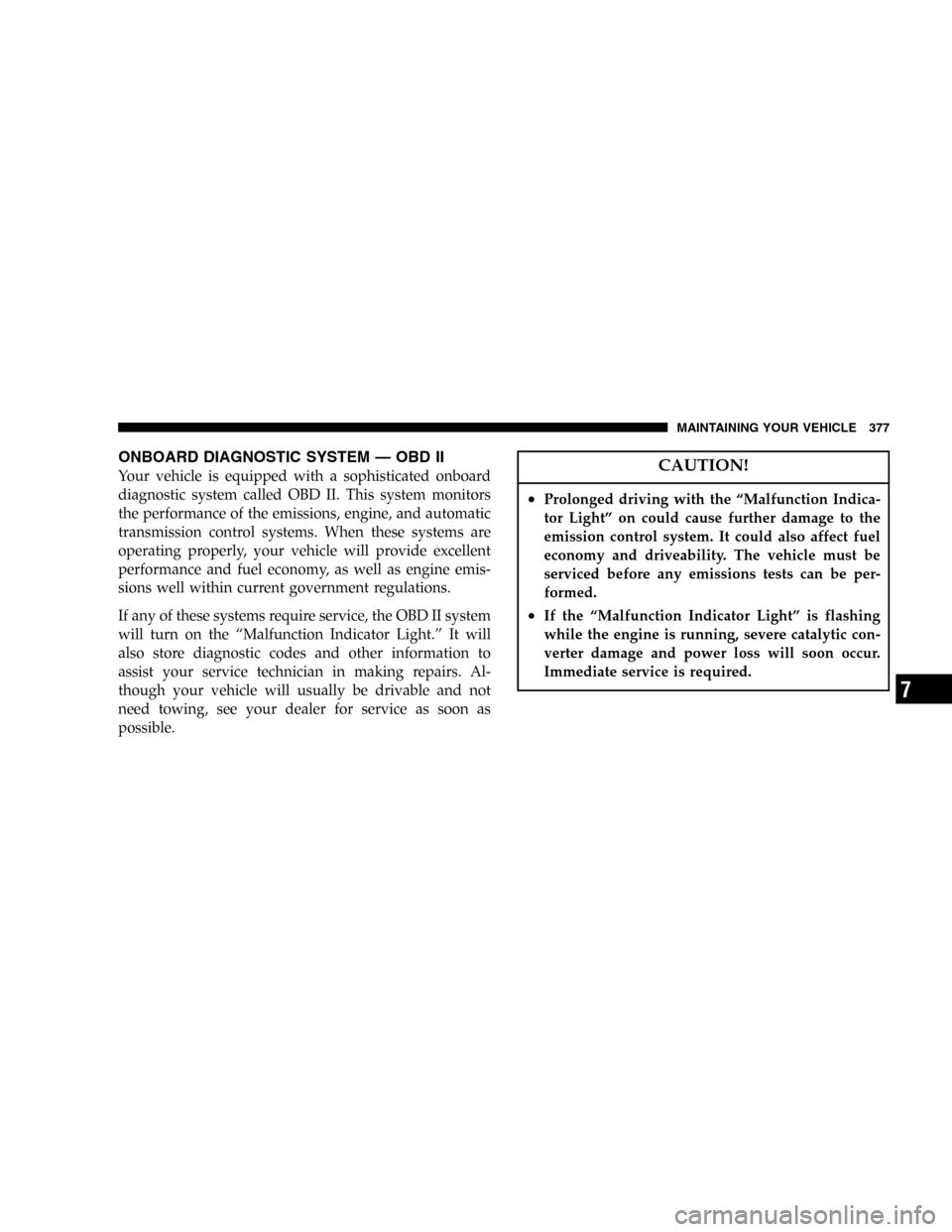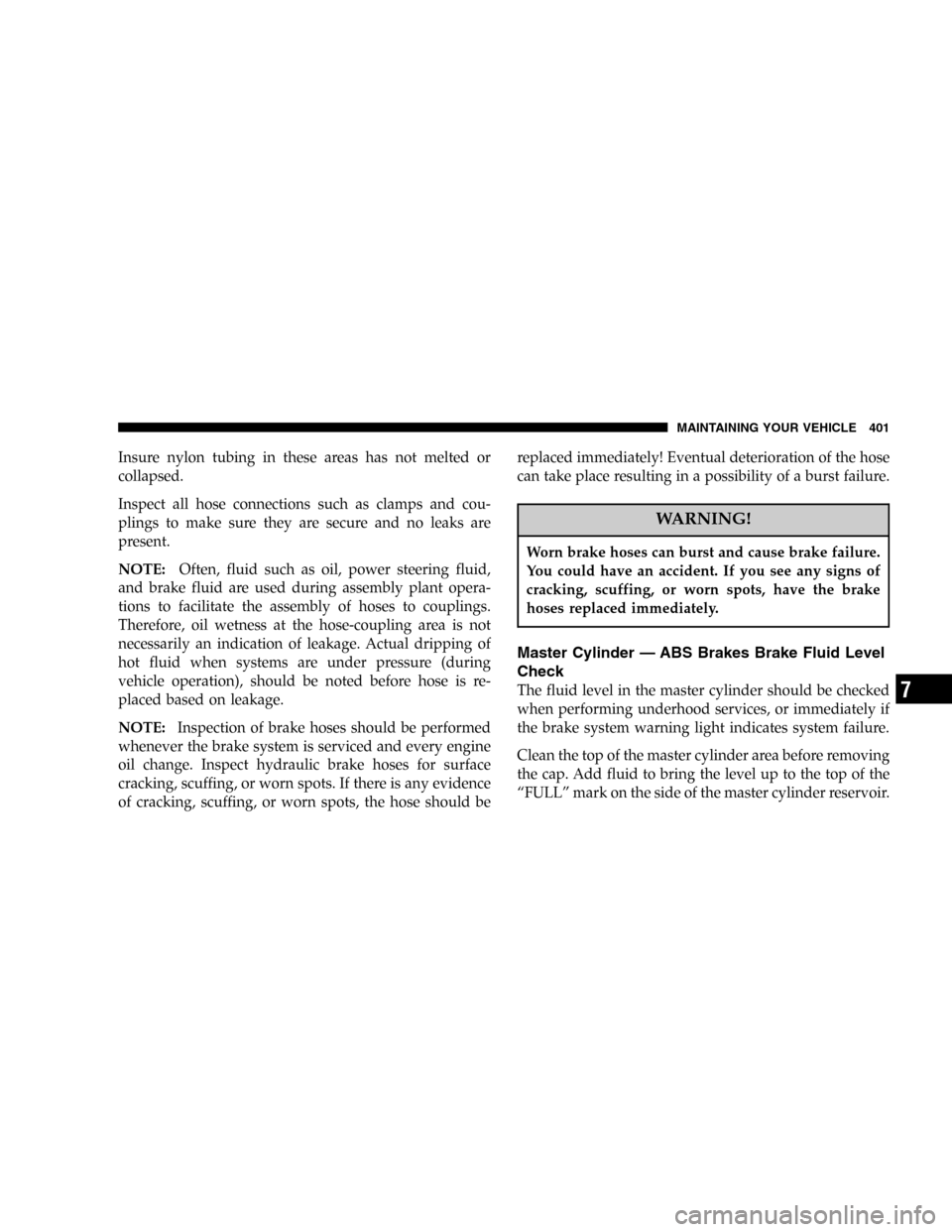Page 377 of 472

ONBOARD DIAGNOSTIC SYSTEM—OBD II
Your vehicle is equipped with a sophisticated onboard
diagnostic system called OBD II. This system monitors
the performance of the emissions, engine, and automatic
transmission control systems. When these systems are
operating properly, your vehicle will provide excellent
performance and fuel economy, as well as engine emis-
sions well within current government regulations.
If any of these systems require service, the OBD II system
will turn on the“Malfunction Indicator Light.”It will
also store diagnostic codes and other information to
assist your service technician in making repairs. Al-
though your vehicle will usually be drivable and not
need towing, see your dealer for service as soon as
possible.CAUTION!
•Prolonged driving with the“Malfunction Indica-
tor Light”on could cause further damage to the
emission control system. It could also affect fuel
economy and driveability. The vehicle must be
serviced before any emissions tests can be per-
formed.
•If the“Malfunction Indicator Light”is flashing
while the engine is running, severe catalytic con-
verter damage and power loss will soon occur.
Immediate service is required.
MAINTAINING YOUR VEHICLE 377
7
Page 393 of 472
Windshield and Rear Window Washers
The fluid reservoir for the windshield washers and the
rear window washer is shared. It is located in the engine
compartment and should be checked for fluid level at
regular intervals. Fill the reservoir with windshield
washer solvent (not radiator antifreeze) and operate the
system for a few seconds to flush out the residual water.
The washer fluid reservoir will hold a full gallon of fluid
when the Low Washer Fluid Light illuminates.
Exhaust System
The best protection against carbon monoxide entry into
the vehicle body is a properly maintained engine exhaust
system.
Whenever a change is noticed in the sound of the exhaust
system, when exhaust fumes can be detected inside the
Washer Fluid Reservoir
MAINTAINING YOUR VEHICLE 393
7
Page 401 of 472

Insure nylon tubing in these areas has not melted or
collapsed.
Inspect all hose connections such as clamps and cou-
plings to make sure they are secure and no leaks are
present.
NOTE:Often, fluid such as oil, power steering fluid,
and brake fluid are used during assembly plant opera-
tions to facilitate the assembly of hoses to couplings.
Therefore, oil wetness at the hose-coupling area is not
necessarily an indication of leakage. Actual dripping of
hot fluid when systems are under pressure (during
vehicle operation), should be noted before hose is re-
placed based on leakage.
NOTE:Inspection of brake hoses should be performed
whenever the brake system is serviced and every engine
oil change. Inspect hydraulic brake hoses for surface
cracking, scuffing, or worn spots. If there is any evidence
of cracking, scuffing, or worn spots, the hose should bereplaced immediately! Eventual deterioration of the hose
can take place resulting in a possibility of a burst failure.
WARNING!
Worn brake hoses can burst and cause brake failure.
You could have an accident. If you see any signs of
cracking, scuffing, or worn spots, have the brake
hoses replaced immediately.
Master Cylinder—ABS Brakes Brake Fluid Level
Check
The fluid level in the master cylinder should be checked
when performing underhood services, or immediately if
the brake system warning light indicates system failure.
Clean the top of the master cylinder area before removing
the cap. Add fluid to bring the level up to the top of the
“FULL”mark on the side of the master cylinder reservoir.
MAINTAINING YOUR VEHICLE 401
7
Page 410 of 472

1. Remove all dirt with a wet soft rag. A mild soap
solution may be used, do not use high alcohol content or
abrasive cleaners. Glass cleaners are not recommended. If
soap is used, wipe clean with a clean damp rag.
2. To maintain the high gloss shine, apply a scratch and
swirl remover onto a damp cloth and apply to door
applique. Rub the applique with a firm pressure then buff
lightly with a clean cotton cloth until a high gloss shine is
achieved.
Glass Surfaces
All glass surfaces should be cleaned on a regular basis
with any commercial household-type glass cleaner.
Never use an abrasive type cleaner. Use caution when
cleaning inside rear windows equipped with electric
defrosters or windshields equipped with a windshield
wiper de-icer. Do not use scrapers or other sharp instru-
ments which may scratch the elements.When cleaning the rear view mirror, spray cleaner on the
towel or rag that you are using. Do not spray cleaner
directly on the mirror.
Cleaning Plastic Instrument Cluster Lenses
The lenses in front of the instruments in this vehicle are
molded in clear plastic. When cleaning the lenses, care
must be taken to avoid scratching the plastic.
1. Clean with a wet soft rag. A mild soap solution may be
used, but do not use high alcohol content or abrasive
cleaners. If soap is used, wipe clean with a clean damp
rag.
2. Dry with a soft tissue.
Seat Belt Maintenance
Do not bleach, dye or clean the belts with chemical
solvents or abrasive cleaners. This will weaken the fabric.
Sun damage will also weaken the fabric.
410 MAINTAINING YOUR VEHICLE
Page 413 of 472
Cavity Maxi Fuse Description
F4 30 Amp
PinkFront Wipers
F9 40 Amp
GreenAnti-Lock Brake System
(ABS) Pump
F10 40 Amp
GreenFront Blower
F13 40 Amp
GreenElectronic Back Light (EBL)
F19 40 Amp
GreenBody Control Module
(BCM) Feed 1
F20 30 Amp
PinkCentral Amplifier
F22 30 Amp
PinkSeats
F27 40 Amp
GreenRadiator FanCavity Maxi Fuse Description
F28 40 Amp
GreenPower Windows
F30 40 Amp
GreenHeadlight Washers (Export
Only)
F31 40 Amp
GreenPower Sliding Door
F32 40 Amp
GreenPower Liftgate
MAINTAINING YOUR VEHICLE 413
7
Page 414 of 472
Cavity Mini Fuse Description
F1 20 Amp Yel-
lowFog Lights
F2 15 Amp Blue Left Park/Tail Light
F3 15 Amp Blue Right Park/Tail Light
F5 20 Amp Yel-
lowRDO/IP Ignition
F6 20 Amp Yel-
low12 Volt Out Ignition or
Battery
F8 20 Amp Yel-
lowHorn
F11 20 Amp Yel-
lowEWD/ Rear Wiper
F12 25 Amp Clear Rear Blower
F14 20 Amp Yel-
lowIgnition Off Draw (IOD)
F15 20 Amp Yel-
lowElectronic Automatic
Transaxle (EATX) BatteryCavity Mini Fuse Description
F15 25 Amp Clear ASD
F17 20 Amp Yel-
lowFuel Pump
F18 15 Amp Blue A/C Clutch
F21 25 Amp Clear Anti-Lock Brake System
(ABS) Module
F23 10 Amp Red Ignition Switch
F24 20 Amp Yel-
lowHazard
F26 20 Amp Yel-
lowStop Lamp
F33 15 Amp Blue Front/Rear Washer
20 Amp Yel-
lowSpare (IOD)
414 MAINTAINING YOUR VEHICLE
Page 416 of 472

air conditioning system at idle for about five minutes
in the fresh air and high blower setting. This will
insure adequate system lubrication to minimize the
possibility of compressor damage when the system is
started again.
REPLACEMENT LIGHT BULBS
LIGHT BULBS—Interior Bulb Number
Center & Rear Dome Light.................. 578
Center & Rear Reading Lights............... 578
Front Door Courtesy Light.................. 578
Front Header Reading Lights—If Equipped..... 578
Instrument Cluster Lights.................PC74
Liftgate Light(s).......................... 578
Overhead Console Reading Lights..........PC579
Removable Console Light—If Equipped....... 194
Visor Vanity Lights....................6501966NOTE:For lighted switches, see your dealer for replace-
ment instructions.
All of the interior bulbs are glass wedge base or glass
cartridge types. Aluminum base bulbs are not approved
and should not be used for replacement.
LIGHT BULBS—Exterior Bulb Number
Back-up, Tail, Stop, Turn Signal, & Sidemarker. . . 3057
Center High-Mounted Stop Light............. 921
Fog Light—If Equipped..................9145
Front Side marker, Park/Turn Signal........3457AK
Headlight.............................9007
Headlight (Long Wheel Base)............... H13
License................................ 168
416 MAINTAINING YOUR VEHICLE
Page 417 of 472
BULB REPLACEMENT
Headlights
1. Remove the three screws securing the headlight mod-
ule.
2. Turn the bulb socket retaining ring or the bulb assem-
bly counterclockwise.3. Disconnect the electrical connector and replace the
bulb.
NOTE:On some vehicles it may be necessary to slide
the red release lock rearward and push forward on the
connector while depressing the release tab.
MAINTAINING YOUR VEHICLE 417
7